View in other NatureServe Network Field Guides
NatureServe
Montana
Utah
Wyoming
Idaho
Wisconsin
British Columbia
South Carolina
Yukon
California
New York
Whorled Milkweed - Asclepias verticillata
Native Species
Global Rank:
G5
State Rank:
S3S4
(see State Rank Reason below)
C-value:
5
Agency Status
USFWS:
USFS:
BLM:
External Links
State Rank Reason (see State Rank above)
Asclepias verticillata is found scattered through half of eastern Montana.
- Details on Status Ranking and Review
Range Extent
ScoreF - 20,000-200,000 sq km (~8,000-80,000 sq mi)
Area of Occupancy
ScoreD - 6-25 4-km2 grid cells
Number of Populations
ScoreC - 21 - 80
Number of Occurrences or Percent Area with Good Viability / Ecological Integrity
ScoreC - Few (4-12) occurrences with excellent or good viability or ecological integrity
Environmental Specificity
ScoreC - Moderate. Generalist or community with some key requirements scarce
Long-term Trend
ScoreU - Unknown
Trends
ScoreU - Unknown
Threats
ScoreU - Unknown
CommentThreats: Unknown/undetermined.
Intrinsic Vulnerability
ScoreC - Not intrinsically vulnerable
General Description
Plants: Perennial, shallowly fibrous-rooted with a little-branched crown; stems mostly simple, sometimes a few (McGregor et al. 1986), 30–60 cm; herbage glabrate to puberulent (Lesica 2012).
Leaves: Usually 3-6 at each node, sessile, spreading, whorled (verticillate), subverticillate (McGregor et al. 1986) or closely alternate (Lesica 2012); blades long and threadlike to linear (McGregor et al. 1986), 2–6 cm in length (Lesica 2012), 0.5-1.5 (3) mm in width, usually leathery (coriaceous), smooth to puberulent (with small hairs barely visible), base and apex both narrowly acute, margins turned under (revolute) (McGregor et al. 1986).
Inflorescences: Few to numerous in the higher leaf axils (McGregor et al. 1986) consisting of umbels of 6 to 20 flowers; peduncles 1–4 cm long (Lesica 2012); pedicels threadlike with minute hairs, 5-11 mm in length (McGregor et al. 1986).
(Lesica's contribution adapted from
Lesica et al. 2012. Manual of Montana Vascular Plants. BRIT Press. Fort Worth, TX)
Phenology
Flowers June-September (McGregor et al. 1986).
Species Range
Montana Range
Range Descriptions
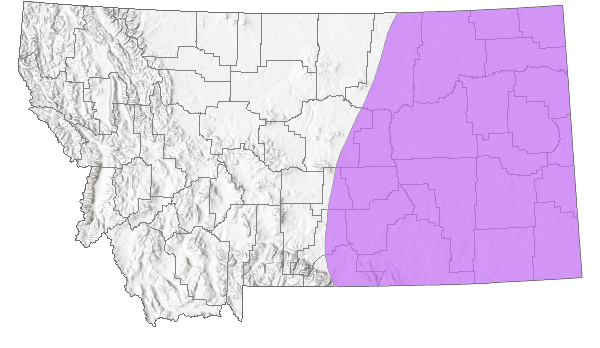
 Native
Native
Range Comments
SK and MT to VT and MA, south to AZ, TX and FL (Lesica 2012; McGregor et al. 1986).
(Lesica's contribution adapted from Lesica et al. 2012. Manual of Montana Vascular Plants. BRIT Press. Fort Worth, TX)
Observations in Montana Natural Heritage Program Database
Number of Observations: 65
(Click on the following maps and charts to see full sized version)
Map Help and Descriptions
Relative Density
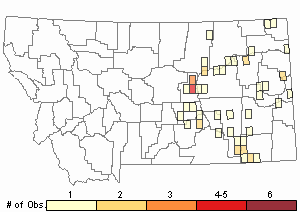
Recency
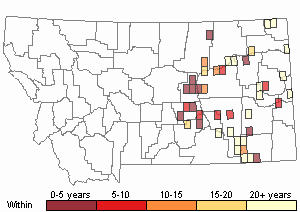
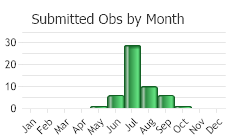
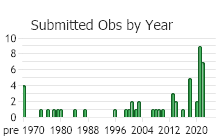
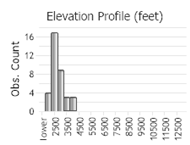 (Observations spanning multiple months or years are excluded from time charts)
(Observations spanning multiple months or years are excluded from time charts)
Habitat
Sandy, clayey, or stony soil of grasslands, badlands, floodplains, and woodlands (Lesica 2012; McGregor et al. 1986).
(Lesica's contribution adapted from
Lesica et al. 2012. Manual of Montana Vascular Plants. BRIT Press. Fort Worth, TX)
Ecology
North America is home to over 100 milkweed species. Monarch conservation groups have listed priority species for each U.S. region. Information pertaining to all aspects of North American monarch (
Danaus plexippus) conservation can be found on the Monarch Joint Venture website.
Quality monarch butterfly habitat must have native milkweed species. Female monarchs only use milkweed plants to lay their eggs on, and monarch larvae must have milkweed to survive. Monarch habitat is supported when native milkweed species are planted or encouraged to grow. Monarchs do visit sites with only a few milkweed plants. However, larger habitats decrease the density of monarchs per plant. This has the potential to reduce both larval competition for food and the spread of disease. Milkweed nectar also nourishes a diversity of pollinators, including other butterflies, honeybees and moths (Willson et al. 1979).
POLLINATORS The following animal species have been reported as pollinators of this plant species or its genus where their geographic ranges overlap:
Bombus vagans,
Bombus huntii,
Bombus rufocinctus,
Bombus ternarius,
Bombus terricola,
Bombus pensylvanicus,
Bombus bimaculatus,
Bombus griseocollis,
Bombus impatiens,
Bombus insularis, and
Bombus flavidus (Plath 1934, Heinrich 1976, Thorp et al. 1983, Colla and Dumesh 2010, Colla et al. 2011, Koch et al. 2012, Williams et al. 2014, Tripoldi and Szalanski 2015).
Reproductive Characteristics
Flowers: Flowers 5–8 mm high; sepals 1–3 mm long, pubescent (Lesica 2012), green or shaded with purple (McGregor et al. 1986); petals greenish-white, purple-tinged, 2–5 mm long, glabrous (Lesica 2012), oval and reflexed (McGregor et al. 1986); gynostegium greenish-white or purplish, glabrous, column ca 1.5 mm high (Lesica 2012), 0.5-0.8 mm in width, nearly cylindric (McGregor et al. 1986); hoods oblong, 1–2 mm long (Lesica 2012); horns clearly exserted and arching over the anther head; corpusculum ca 0.2 mm in length; pollinia ca 1 mm in length. Follicles on curved to straight stalks (McGregor et al. 1986), ascending to erect, fusiform, smooth, puberulent, 8–10 cm long (Lesica 2012).
Fruit: Seeds 5-6 mm in length, broadly egg-shaped, with a tuft of soft white hairs (coma), 2.5-3.5 cm in length (McGregor et al. 1986).
(Lesica's contribution adapted from
Lesica et al. 2012. Manual of Montana Vascular Plants. BRIT Press. Fort Worth, TX)
Management
This species is toxic to farm animals (McGregor et al. 1986).
ECONOMIC VALUE
Milkweed populations provide nourishment and habitat to pollinators (Monarch Joint Venture 2015; Willson et al. 1979), which supports agricultural crops that also require insect pollination (Nabhan & Buchmann 1997), improves fruit conditions for market (Garratt et al. 2014), raises the nutritional value of certain foods, (Bommarco et al. 2012), and sustains various levels of the food web (Gilgert and Vaughan 2011).
Asclepias verticillata is recommended for planting in order to develop habitat for the Monarch Butterfly (Monarch Joint Venture 2015) and to improve pollinator habitat for raising agricultural crops.
Stewardship Responsibility
References
- Literature Cited AboveLegend:
 View Online Publication
View Online Publication Bommarco, R., L. Marini, and B.E. Vaissière. 2012. Insect pollination enhances seed yield, quality, and market value in oilseed rape. Oecologia 169(4):1025-1032.
Bommarco, R., L. Marini, and B.E. Vaissière. 2012. Insect pollination enhances seed yield, quality, and market value in oilseed rape. Oecologia 169(4):1025-1032. Colla, S., L. Richardson, and P. Williams. 2011. Bumble bees of the eastern United States. Washington, DC: USDA Forest Service, Pollinator Partnership. 103 p.
Colla, S., L. Richardson, and P. Williams. 2011. Bumble bees of the eastern United States. Washington, DC: USDA Forest Service, Pollinator Partnership. 103 p. Colla, S.R. and S. Dumesh. 2010. The bumble bees of southern Ontario: notes on natural history and distribution. Journal of the Entomological Society of Ontario 141:39-68.
Colla, S.R. and S. Dumesh. 2010. The bumble bees of southern Ontario: notes on natural history and distribution. Journal of the Entomological Society of Ontario 141:39-68. Garratt, M.P.D., T.D. Breeze, N. Jenner, C. Polce, J.C. Biesmeijer, and S.G. Potts. 2014. Avoiding a bad apple: insect pollination enhances fruit quality and economic value. Agriculture, Ecosystems & Environment 184(Feb):34-40.
Garratt, M.P.D., T.D. Breeze, N. Jenner, C. Polce, J.C. Biesmeijer, and S.G. Potts. 2014. Avoiding a bad apple: insect pollination enhances fruit quality and economic value. Agriculture, Ecosystems & Environment 184(Feb):34-40. Koch, J., J. Strange, and P. Williams. 2012. Bumble bees of the western United States. Washington, DC: USDA Forest Service, Pollinator Partnership. 143 p.
Koch, J., J. Strange, and P. Williams. 2012. Bumble bees of the western United States. Washington, DC: USDA Forest Service, Pollinator Partnership. 143 p. Lesica, P., M.T. Lavin, and P.F. Stickney. 2012. Manual of Montana Vascular Plants. Fort Worth, TX: BRIT Press. viii + 771 p.
Lesica, P., M.T. Lavin, and P.F. Stickney. 2012. Manual of Montana Vascular Plants. Fort Worth, TX: BRIT Press. viii + 771 p. McGregor, R.L. (coordinator), T.M. Barkley, R.E. Brooks, and E.K. Schofield (eds). 1986. Flora of the Great Plains: Great Plains Flora Association. Lawrence, KS: Univ. Press Kansas. 1392 pp.
McGregor, R.L. (coordinator), T.M. Barkley, R.E. Brooks, and E.K. Schofield (eds). 1986. Flora of the Great Plains: Great Plains Flora Association. Lawrence, KS: Univ. Press Kansas. 1392 pp. Monarch Joint Venture: Partnering to conserve the monarch butterfly migration. 2015. St. Paul, MN: University of Minnesota, Department of Fisheries, Wildlife, and Conservation Biology.
Monarch Joint Venture: Partnering to conserve the monarch butterfly migration. 2015. St. Paul, MN: University of Minnesota, Department of Fisheries, Wildlife, and Conservation Biology. Nabhan, G.P. and S. Buchmann. 1997. Services provided by pollinators. pp. 133–150 In: G.C. Daily (ed). Nature's services: societal dependence on natural ecosystems. Washington, DC: Island Press. 392 p.
Nabhan, G.P. and S. Buchmann. 1997. Services provided by pollinators. pp. 133–150 In: G.C. Daily (ed). Nature's services: societal dependence on natural ecosystems. Washington, DC: Island Press. 392 p. Plath, O.E. 1934. Bumblebees and their ways. New York, NY: Macmillan Company. 201 p.
Plath, O.E. 1934. Bumblebees and their ways. New York, NY: Macmillan Company. 201 p. Thorp, R.W., D.S. Horning, and L.L. Dunning. 1983. Bumble bees and cuckoo bumble bees of California (Hymenoptera: Apidae). Bulletin of the California Insect Survey 23:1-79.
Thorp, R.W., D.S. Horning, and L.L. Dunning. 1983. Bumble bees and cuckoo bumble bees of California (Hymenoptera: Apidae). Bulletin of the California Insect Survey 23:1-79. Tripoldi, A.D. and A.L. Szalanski. 2015. The bumble bees (Hymenoptera: Apidae: Bombus) of Arkansas, fifty years later. Journal of Melittology 50: doi: http://dx.doi.org/10.17161/jom.v0i50.4834
Tripoldi, A.D. and A.L. Szalanski. 2015. The bumble bees (Hymenoptera: Apidae: Bombus) of Arkansas, fifty years later. Journal of Melittology 50: doi: http://dx.doi.org/10.17161/jom.v0i50.4834 Wendell, G. and M. Vaughan. 2011. The value of pollinators and pollinator habitat to rangelands: Connections among pollinators, insects, plant communities, fish, and wildlife, Rangelands 33(3):14-19.
Wendell, G. and M. Vaughan. 2011. The value of pollinators and pollinator habitat to rangelands: Connections among pollinators, insects, plant communities, fish, and wildlife, Rangelands 33(3):14-19. Williams, P., R. Thorp, L. Richardson, and S. Colla. 2014. Bumble Bees of North America. Princeton, NJ: Princeton University Press. 208 p.
Williams, P., R. Thorp, L. Richardson, and S. Colla. 2014. Bumble Bees of North America. Princeton, NJ: Princeton University Press. 208 p. Willson, M.F., R.I. Bertin, and P.W. Price. 1979. Nectar production and flower visitors of Asclepias verticillata. American Midland Naturalist 102(1):23-35.
Willson, M.F., R.I. Bertin, and P.W. Price. 1979. Nectar production and flower visitors of Asclepias verticillata. American Midland Naturalist 102(1):23-35.
- Additional ReferencesLegend:
 View Online Publication
View Online Publication
Do you know of a citation we're missing? Boggs, K. W. 1984. Succession in riparian communities of the lower Yellowstone River, Montana. M.S. Thesis. Montana State University, Bozeman, 107 pp.
Boggs, K. W. 1984. Succession in riparian communities of the lower Yellowstone River, Montana. M.S. Thesis. Montana State University, Bozeman, 107 pp. Britton, N. L. and A. B. Brown. 1913. An Illustrated Flora of the Northern United States, Canada, and the British Possessions. 2nd Edition in 3 Volumes. New York, NY: Charles Scribner's Sons. B13BRI01PAUS.
Britton, N. L. and A. B. Brown. 1913. An Illustrated Flora of the Northern United States, Canada, and the British Possessions. 2nd Edition in 3 Volumes. New York, NY: Charles Scribner's Sons. B13BRI01PAUS. DuBois, K.L. 1979. An inventory of the avifauna in the Long Pines of Southeastern Montana. M.Sc. Thesis. Bozeman, MT: Montana State University. 113 p.
DuBois, K.L. 1979. An inventory of the avifauna in the Long Pines of Southeastern Montana. M.Sc. Thesis. Bozeman, MT: Montana State University. 113 p. Eggers, M.J.S. 2005. Riparian vegetation of the Montana Yellowstone and cattle grazing impacts thereon. M.Sc. Thesis. Montana State University, Bozeman, MT. 125 p.
Eggers, M.J.S. 2005. Riparian vegetation of the Montana Yellowstone and cattle grazing impacts thereon. M.Sc. Thesis. Montana State University, Bozeman, MT. 125 p. Klein, A.M., B.E. Vaissière, J. H. Cane, I. Steffan-Dewenter, S.A.Cunningham, C. Kremen and T. Tscharntke. 2007. Importance of pollinators in changing landscapes for world crops. Proceedings of the Royal Society B: Biological Sciences, 274(1608):303-313.
Klein, A.M., B.E. Vaissière, J. H. Cane, I. Steffan-Dewenter, S.A.Cunningham, C. Kremen and T. Tscharntke. 2007. Importance of pollinators in changing landscapes for world crops. Proceedings of the Royal Society B: Biological Sciences, 274(1608):303-313. Lesica, P., M.T. Lavin, and P.F. Stickney. 2022. Manual of Montana Vascular Plants, Second Edition. Fort Worth, TX: BRIT Press. viii + 779 p.
Lesica, P., M.T. Lavin, and P.F. Stickney. 2022. Manual of Montana Vascular Plants, Second Edition. Fort Worth, TX: BRIT Press. viii + 779 p. Nicole, W. 2015. Pollinator power: benefits of an ecosystem service. Environmental Health Perspectives 123(8):A210-A215.
Nicole, W. 2015. Pollinator power: benefits of an ecosystem service. Environmental Health Perspectives 123(8):A210-A215. Rundquist, V.M. 1973. Avian ecology on stock ponds in two vegetational types in north-central Montana. Ph.D. Dissertation. Bozeman, MT: Montana State University. 112 p.
Rundquist, V.M. 1973. Avian ecology on stock ponds in two vegetational types in north-central Montana. Ph.D. Dissertation. Bozeman, MT: Montana State University. 112 p. Seipel, T.F. 2006. Plant species diversity in the sagebrush steppe of Montana. M.Sc. Thesis. Bozeman, MT: Montana State University. 87 p.
Seipel, T.F. 2006. Plant species diversity in the sagebrush steppe of Montana. M.Sc. Thesis. Bozeman, MT: Montana State University. 87 p.
- Web Search Engines for Articles on "Whorled Milkweed"





